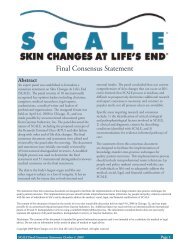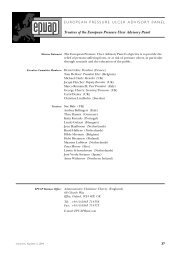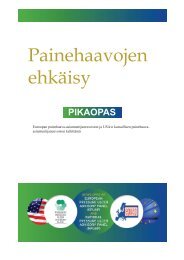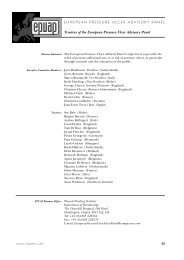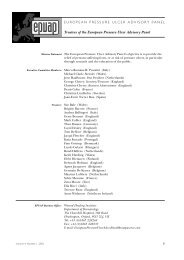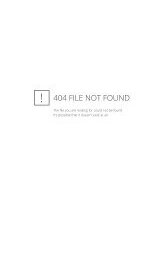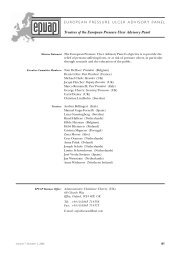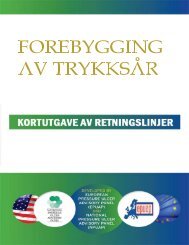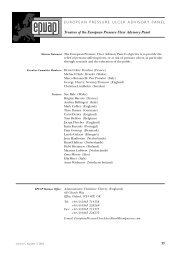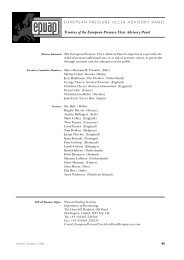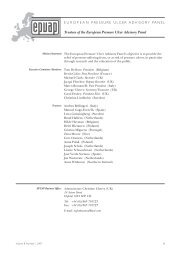EPUAP Review 10.1.indd - European Pressure Ulcer Advisory Panel
EPUAP Review 10.1.indd - European Pressure Ulcer Advisory Panel
EPUAP Review 10.1.indd - European Pressure Ulcer Advisory Panel
You also want an ePaper? Increase the reach of your titles
YUMPU automatically turns print PDFs into web optimized ePapers that Google loves.
EUROPEAN PRESSURE ULCER ADVISORY PANEL<br />
12. Protect the skin from exposure to excessive moisture with a barrier<br />
product in order to reduce the risk of pressure damage. (Strength of<br />
Evidence = C)<br />
The mechanical properties of the stratum corneum are changed by the<br />
presence of moisture and as a function of temperature.<br />
GENERAL RECOMMENDATIONS<br />
1. Screen and assess nutritional status for every individual at risk of pressure<br />
ulcers in each health care setting. (Strength of Evidence = C)<br />
Since under-nutrition is a reversible risk factor for pressure ulcer development,<br />
early identification and management of under-nutrition is very<br />
important. Individuals at risk of pressure ulcer development may also<br />
be at risk of under-nutrition and so should be screened for nutritional<br />
status.<br />
1.1 Use a valid, reliable and practical tool for nutritional screening<br />
that is quick and easy to use and acceptable to both the individual and<br />
health care worker. (Strength of Evidence = C)<br />
It is important that the screening tool is validated, reliable and relevant<br />
to the patient group it is assessing. It is also important that the same<br />
tool can be used in different care settings to encourage continuity of<br />
care.<br />
1.2 Have a nutritional screening policy in place in all health<br />
care settings, along with recommended frequency of screening for<br />
implementation. (Strength of Evidence = C)<br />
Each health care setting should have a policy about nutritional screening.<br />
Results of screening, especially when action is required, should be<br />
communicated from one care setting to another<br />
2. Refer each individual with nutritional risk and pressure ulcer risk to a<br />
registered dietitian and also, if needed to a multidisciplinary nutritional<br />
team including a registered dietitian, a nurse specialized in nutrition,<br />
physician, speech and language therapist, occupational therapist and/<br />
or dentist. (Strength of Evidence = C)<br />
If the nutritional screening identifies individuals prone to develop pressure<br />
ulcers, to be malnourished or at nutritional risk, then a more comprehensive<br />
nutritional assessment should be undertaken by a registered<br />
dietitian or a multidisciplinary nutritional team.<br />
2.1 Provide nutritional support to each individual with nutritional<br />
risk and pressure ulcer risk, following the nutritional cycle. This should<br />
include:<br />
• Nutritional assessment<br />
• Estimation of nutritional requirements<br />
• Comparison of nutrient intake with estimated requirements<br />
• Provide appropriate nutrition intervention, based on appropriate<br />
feeding route<br />
• Monitoring and evaluation of nutritional outcome, with reassessment of<br />
nutritional status at frequent intervals while an individual is at risk.<br />
(Strength of Evidence = C)<br />
Individuals may need different forms of nutritional management<br />
during the course of their illness.<br />
2.2 Follow relevant and evidence based guidelines on enteral nutrition<br />
and hydration for individuals at risk of pressure ulcers, who show<br />
nutritional risks or nutritional problems. (Strength of Evidence = C)<br />
8<br />
Volume 10, Number 1, 2009



